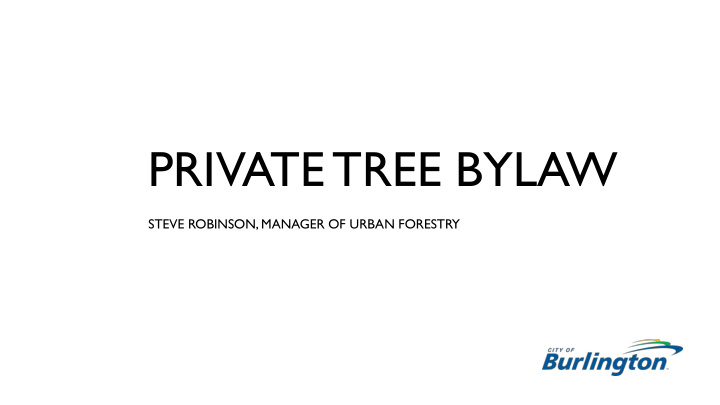



PRIVATE TREE BYLAW STEVE ROBINSON, MANAGER OF URBAN FORESTRY
PRIVATE TREE BYLAW – PROTECTION More than 5 trees in one Any tree greater than 20 cm calendar year with a diameter in diameter range between 10 cm and 20 cm. Trees classified as endangered, Heritage Trees under the threatened, or at-risk species, Ontario Heritage Act, 1990 as defined by the Species at are protected Risk Act, 2002.
PRIVATE TREE BYLAW – EXEMPTIONS For Emergency Work Pruning in accordance (considered work of an For an Imminently with Good Arboricultural urgent nature, such as hazardous tree Practice utility repairs) If the tree is classified Other aspects of under the Invasive provincial legislation Species Act, 2015, or supersede the private listed as a noxious weed tree bylaw which are defined by the Weed discussed in Section 3.0: Control Act, 1990. Applicable Legislation.
PRIVATE TREE BYLAW – PERMIT REQ’D , FEE EXEMPT • Terminally Diseased Trees (EAB, BBB) • Dead Trees • Trees within 2 m of an Occupied Dwelling
PRIVATE TREE BYLAW – URBAN BOUNDARY
PRIVATE TREE BYLAW –DEV’T PERMIT PROCESS Review Process to take approximately 8 hours to complete. Several opportunities for staff to liaise with applicants and vice versa. Proven success of retaining mature trees through construction process based on Roseland Pilot. ‘Development’ considered any application requiring a grading and drainage clearance certificate, zoning clearance, and/or building permit.
PRIVATE TREE BYLAW – NON- DEV’T PERMIT PROCESS Review Process to take approximately 4 hours to complete. Non-development process considered for landscaping, pool installations, decks, patios, & other general tree removal.
PRIVATE TREE BYLAW – RATES & FEES Dual stream permit applications for Development & Non-Development Related Applications: • Development related Tree Permit Applications per property : $680 • Non-Development related Tree Permit Applications per property: $390 • Private Tree Bylaw Contravention Fee (per tree): $680 • Replacement Compensation (CIL/replacement): $400
ANTICIPATED COST RECOVERY & WORKLOAD • Estimated Development Related Permits: 250 Tree Permits ($680 per permit application) • Revenue: $170,000 $60k $170k • Estimated Non-Development Related Permits: 750 ($390 per permit application) • Revenue: $290,000 $290k • Total: $520,000 Dev't Permits Non-Dev't Permits Shortfall
ROLE OF THE FOREST PROTECTION OFFICER Plan review as part of the Educating residents and development process, and liaising developers as to the nature of with homeowners as a valued the bylaw and the importance of partner in the discussion of tree trees preservation within the City Conducting ongoing tracking and Ensuring permit conditions and analysis as to the efficacy of the all other aspects of both the bylaw and providing residents and public and private tree bylaw are members of council with these adhered to and pursue fees and metrics on a regular basis fines as required.
COMPENSATION – REPLACEMENT OR CASH IN LIEU Generally, 1 replacement tree required for every 10 cm removed, or cash in lieu of $400 per replacement tree. 70% 30% Replacement tree size is 30 mm caliper minimum, or 125 cm for conifer. Eg. 30 cm tree to be removed, in fair (70%) condition. 30 x .7 = 21 21/10 = 2.1 2.1 replacement trees required or CIL of $800 (or combination)
INVESTMENT Funds that are received as cash-in-lieu of replacement are recommended to be re- invested into planting initiatives on private land . Some examples of programs are: Discounted rates for Free tree giveaways with homeowner tree purchases tree planting workshops at participating nurseries Caliper tree planting on Subsidized naturalization private land through a planting initiatives for rural third-party vendor property owners
Recommend
More recommend